GNED500 Social Analysis Report on Homelessness: Analysis and Solutions
VerifiedAdded on 2022/11/13
|8
|1854
|462
Report
AI Summary
This social analysis report examines the complex issue of homelessness, focusing on the context of Toronto and the GNED500 course. The report begins with an introduction that defines the problem and connects it to course ideologies like classism and fascism. It then delves into the structures, individual acts, and prevalent ideologies that contribute to homelessness, including lack of affordable housing, mental health issues, and societal stereotypes. The analysis incorporates data and perspectives from various sources, including government reports and academic research. Finally, the report proposes solutions, such as increasing access to soup kitchens, employment, and education services, and advocating for more subsidized housing. The report concludes with a bibliography of cited sources.

1
Social Analysis Report
1| P a g e
Social Analysis Report
1| P a g e
Paraphrase This Document
Need a fresh take? Get an instant paraphrase of this document with our AI Paraphraser

2
Table of Contents
Introduction.................................................................................................................................. 3
Structures.................................................................................................................................... 3
Individual Acts............................................................................................................................. 3
Ideologies.................................................................................................................................... 4
Solutions...................................................................................................................................... 5
Bibliography................................................................................................................................. 7
2| P a g e
Table of Contents
Introduction.................................................................................................................................. 3
Structures.................................................................................................................................... 3
Individual Acts............................................................................................................................. 3
Ideologies.................................................................................................................................... 4
Solutions...................................................................................................................................... 5
Bibliography................................................................................................................................. 7
2| P a g e
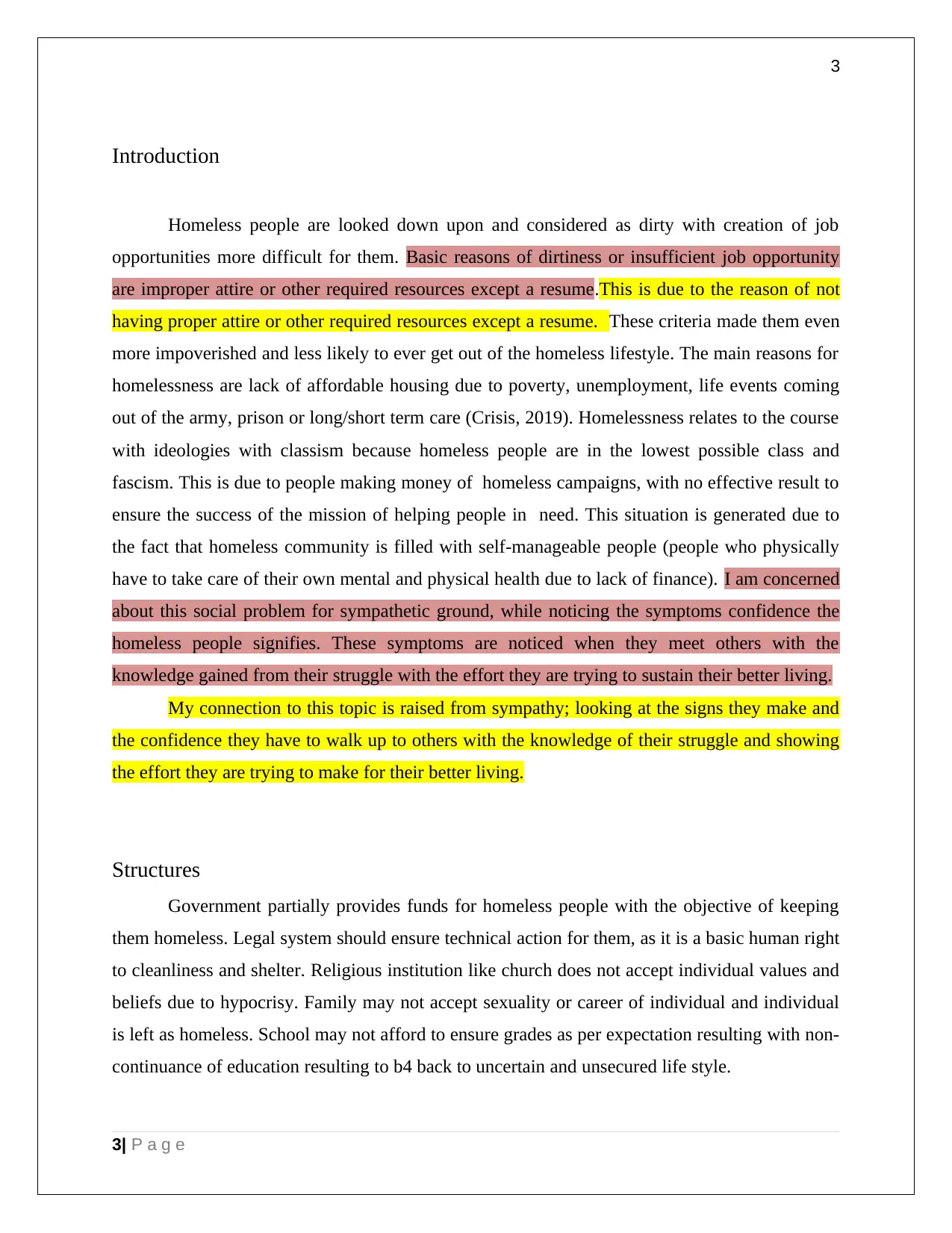
3
Introduction
Homeless people are looked down upon and considered as dirty with creation of job
opportunities more difficult for them. Basic reasons of dirtiness or insufficient job opportunity
are improper attire or other required resources except a resume.This is due to the reason of not
having proper attire or other required resources except a resume. These criteria made them even
more impoverished and less likely to ever get out of the homeless lifestyle. The main reasons for
homelessness are lack of affordable housing due to poverty, unemployment, life events coming
out of the army, prison or long/short term care (Crisis, 2019). Homelessness relates to the course
with ideologies with classism because homeless people are in the lowest possible class and
fascism. This is due to people making money of homeless campaigns, with no effective result to
ensure the success of the mission of helping people in need. This situation is generated due to
the fact that homeless community is filled with self-manageable people (people who physically
have to take care of their own mental and physical health due to lack of finance). I am concerned
about this social problem for sympathetic ground, while noticing the symptoms confidence the
homeless people signifies. These symptoms are noticed when they meet others with the
knowledge gained from their struggle with the effort they are trying to sustain their better living.
My connection to this topic is raised from sympathy; looking at the signs they make and
the confidence they have to walk up to others with the knowledge of their struggle and showing
the effort they are trying to make for their better living.
Structures
Government partially provides funds for homeless people with the objective of keeping
them homeless. Legal system should ensure technical action for them, as it is a basic human right
to cleanliness and shelter. Religious institution like church does not accept individual values and
beliefs due to hypocrisy. Family may not accept sexuality or career of individual and individual
is left as homeless. School may not afford to ensure grades as per expectation resulting with non-
continuance of education resulting to b4 back to uncertain and unsecured life style.
3| P a g e
Introduction
Homeless people are looked down upon and considered as dirty with creation of job
opportunities more difficult for them. Basic reasons of dirtiness or insufficient job opportunity
are improper attire or other required resources except a resume.This is due to the reason of not
having proper attire or other required resources except a resume. These criteria made them even
more impoverished and less likely to ever get out of the homeless lifestyle. The main reasons for
homelessness are lack of affordable housing due to poverty, unemployment, life events coming
out of the army, prison or long/short term care (Crisis, 2019). Homelessness relates to the course
with ideologies with classism because homeless people are in the lowest possible class and
fascism. This is due to people making money of homeless campaigns, with no effective result to
ensure the success of the mission of helping people in need. This situation is generated due to
the fact that homeless community is filled with self-manageable people (people who physically
have to take care of their own mental and physical health due to lack of finance). I am concerned
about this social problem for sympathetic ground, while noticing the symptoms confidence the
homeless people signifies. These symptoms are noticed when they meet others with the
knowledge gained from their struggle with the effort they are trying to sustain their better living.
My connection to this topic is raised from sympathy; looking at the signs they make and
the confidence they have to walk up to others with the knowledge of their struggle and showing
the effort they are trying to make for their better living.
Structures
Government partially provides funds for homeless people with the objective of keeping
them homeless. Legal system should ensure technical action for them, as it is a basic human right
to cleanliness and shelter. Religious institution like church does not accept individual values and
beliefs due to hypocrisy. Family may not accept sexuality or career of individual and individual
is left as homeless. School may not afford to ensure grades as per expectation resulting with non-
continuance of education resulting to b4 back to uncertain and unsecured life style.
3| P a g e
⊘ This is a preview!⊘
Do you want full access?
Subscribe today to unlock all pages.

Trusted by 1+ million students worldwide
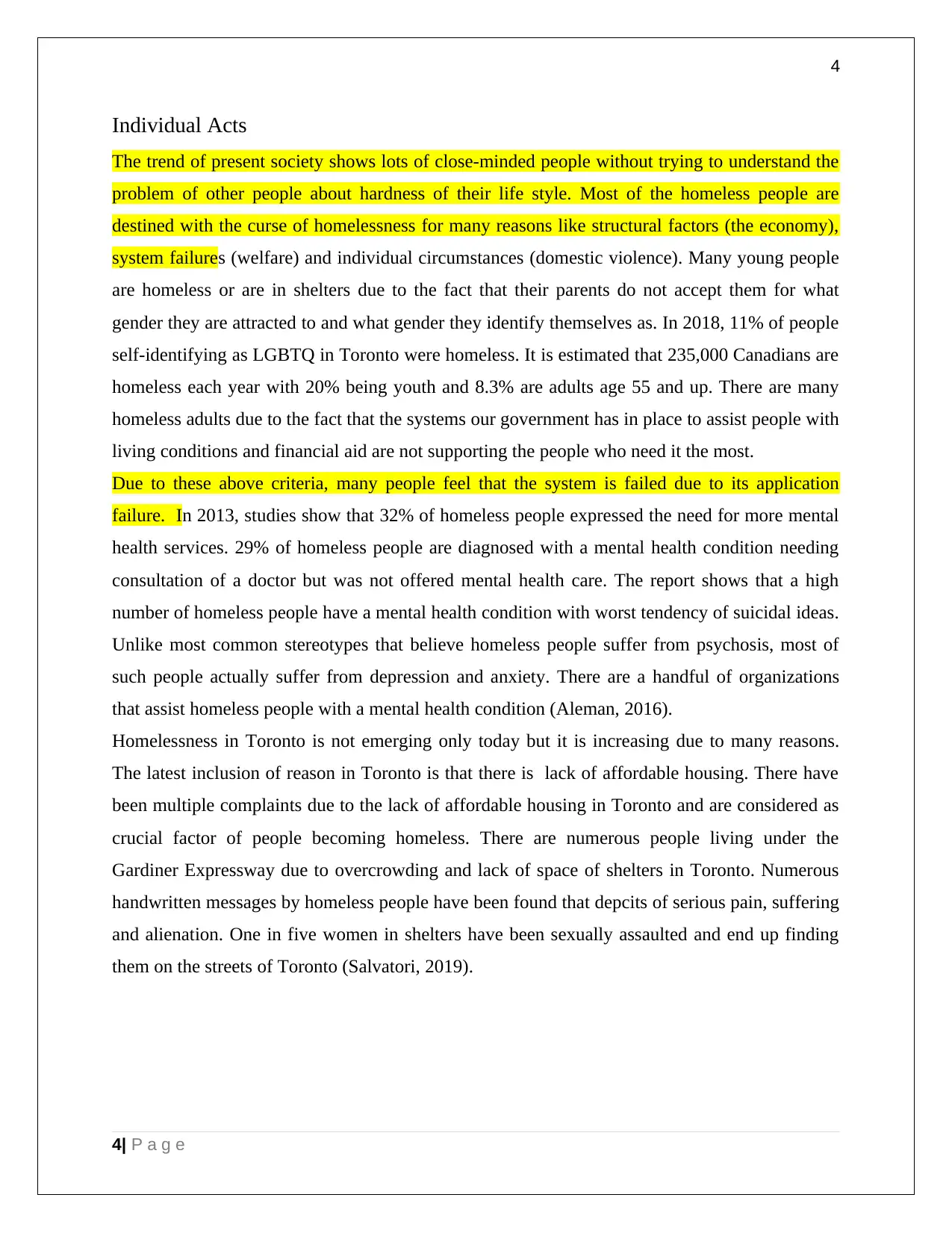
4
Individual Acts
The trend of present society shows lots of close-minded people without trying to understand the
problem of other people about hardness of their life style. Most of the homeless people are
destined with the curse of homelessness for many reasons like structural factors (the economy),
system failures (welfare) and individual circumstances (domestic violence). Many young people
are homeless or are in shelters due to the fact that their parents do not accept them for what
gender they are attracted to and what gender they identify themselves as. In 2018, 11% of people
self-identifying as LGBTQ in Toronto were homeless. It is estimated that 235,000 Canadians are
homeless each year with 20% being youth and 8.3% are adults age 55 and up. There are many
homeless adults due to the fact that the systems our government has in place to assist people with
living conditions and financial aid are not supporting the people who need it the most.
Due to these above criteria, many people feel that the system is failed due to its application
failure. In 2013, studies show that 32% of homeless people expressed the need for more mental
health services. 29% of homeless people are diagnosed with a mental health condition needing
consultation of a doctor but was not offered mental health care. The report shows that a high
number of homeless people have a mental health condition with worst tendency of suicidal ideas.
Unlike most common stereotypes that believe homeless people suffer from psychosis, most of
such people actually suffer from depression and anxiety. There are a handful of organizations
that assist homeless people with a mental health condition (Aleman, 2016).
Homelessness in Toronto is not emerging only today but it is increasing due to many reasons.
The latest inclusion of reason in Toronto is that there is lack of affordable housing. There have
been multiple complaints due to the lack of affordable housing in Toronto and are considered as
crucial factor of people becoming homeless. There are numerous people living under the
Gardiner Expressway due to overcrowding and lack of space of shelters in Toronto. Numerous
handwritten messages by homeless people have been found that depcits of serious pain, suffering
and alienation. One in five women in shelters have been sexually assaulted and end up finding
them on the streets of Toronto (Salvatori, 2019).
4| P a g e
Individual Acts
The trend of present society shows lots of close-minded people without trying to understand the
problem of other people about hardness of their life style. Most of the homeless people are
destined with the curse of homelessness for many reasons like structural factors (the economy),
system failures (welfare) and individual circumstances (domestic violence). Many young people
are homeless or are in shelters due to the fact that their parents do not accept them for what
gender they are attracted to and what gender they identify themselves as. In 2018, 11% of people
self-identifying as LGBTQ in Toronto were homeless. It is estimated that 235,000 Canadians are
homeless each year with 20% being youth and 8.3% are adults age 55 and up. There are many
homeless adults due to the fact that the systems our government has in place to assist people with
living conditions and financial aid are not supporting the people who need it the most.
Due to these above criteria, many people feel that the system is failed due to its application
failure. In 2013, studies show that 32% of homeless people expressed the need for more mental
health services. 29% of homeless people are diagnosed with a mental health condition needing
consultation of a doctor but was not offered mental health care. The report shows that a high
number of homeless people have a mental health condition with worst tendency of suicidal ideas.
Unlike most common stereotypes that believe homeless people suffer from psychosis, most of
such people actually suffer from depression and anxiety. There are a handful of organizations
that assist homeless people with a mental health condition (Aleman, 2016).
Homelessness in Toronto is not emerging only today but it is increasing due to many reasons.
The latest inclusion of reason in Toronto is that there is lack of affordable housing. There have
been multiple complaints due to the lack of affordable housing in Toronto and are considered as
crucial factor of people becoming homeless. There are numerous people living under the
Gardiner Expressway due to overcrowding and lack of space of shelters in Toronto. Numerous
handwritten messages by homeless people have been found that depcits of serious pain, suffering
and alienation. One in five women in shelters have been sexually assaulted and end up finding
them on the streets of Toronto (Salvatori, 2019).
4| P a g e
Paraphrase This Document
Need a fresh take? Get an instant paraphrase of this document with our AI Paraphraser
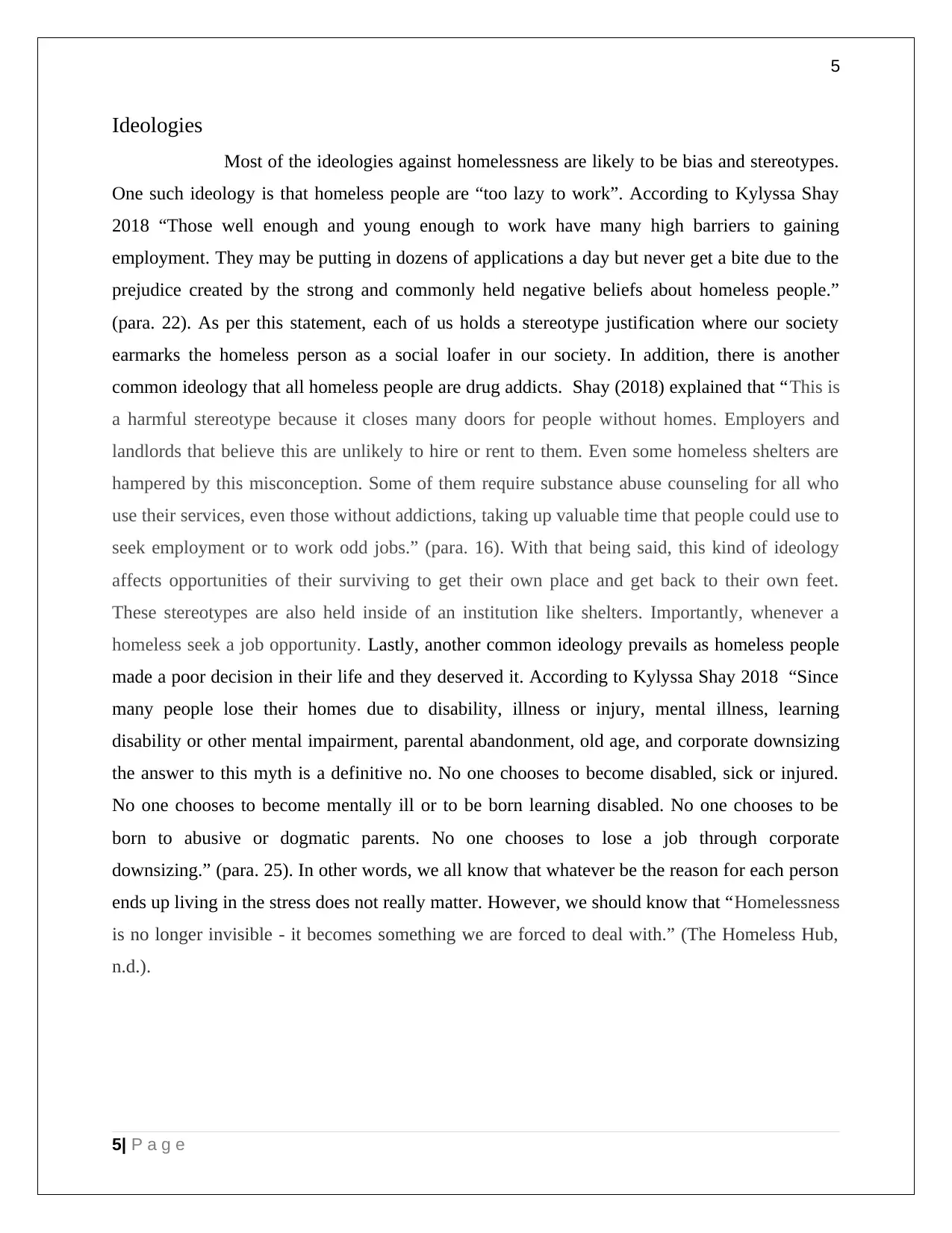
5
Ideologies
Most of the ideologies against homelessness are likely to be bias and stereotypes.
One such ideology is that homeless people are “too lazy to work”. According to Kylyssa Shay
2018 “Those well enough and young enough to work have many high barriers to gaining
employment. They may be putting in dozens of applications a day but never get a bite due to the
prejudice created by the strong and commonly held negative beliefs about homeless people.”
(para. 22). As per this statement, each of us holds a stereotype justification where our society
earmarks the homeless person as a social loafer in our society. In addition, there is another
common ideology that all homeless people are drug addicts. Shay (2018) explained that “This is
a harmful stereotype because it closes many doors for people without homes. Employers and
landlords that believe this are unlikely to hire or rent to them. Even some homeless shelters are
hampered by this misconception. Some of them require substance abuse counseling for all who
use their services, even those without addictions, taking up valuable time that people could use to
seek employment or to work odd jobs.” (para. 16). With that being said, this kind of ideology
affects opportunities of their surviving to get their own place and get back to their own feet.
These stereotypes are also held inside of an institution like shelters. Importantly, whenever a
homeless seek a job opportunity. Lastly, another common ideology prevails as homeless people
made a poor decision in their life and they deserved it. According to Kylyssa Shay 2018 “Since
many people lose their homes due to disability, illness or injury, mental illness, learning
disability or other mental impairment, parental abandonment, old age, and corporate downsizing
the answer to this myth is a definitive no. No one chooses to become disabled, sick or injured.
No one chooses to become mentally ill or to be born learning disabled. No one chooses to be
born to abusive or dogmatic parents. No one chooses to lose a job through corporate
downsizing.” (para. 25). In other words, we all know that whatever be the reason for each person
ends up living in the stress does not really matter. However, we should know that “Homelessness
is no longer invisible - it becomes something we are forced to deal with.” (The Homeless Hub,
n.d.).
5| P a g e
Ideologies
Most of the ideologies against homelessness are likely to be bias and stereotypes.
One such ideology is that homeless people are “too lazy to work”. According to Kylyssa Shay
2018 “Those well enough and young enough to work have many high barriers to gaining
employment. They may be putting in dozens of applications a day but never get a bite due to the
prejudice created by the strong and commonly held negative beliefs about homeless people.”
(para. 22). As per this statement, each of us holds a stereotype justification where our society
earmarks the homeless person as a social loafer in our society. In addition, there is another
common ideology that all homeless people are drug addicts. Shay (2018) explained that “This is
a harmful stereotype because it closes many doors for people without homes. Employers and
landlords that believe this are unlikely to hire or rent to them. Even some homeless shelters are
hampered by this misconception. Some of them require substance abuse counseling for all who
use their services, even those without addictions, taking up valuable time that people could use to
seek employment or to work odd jobs.” (para. 16). With that being said, this kind of ideology
affects opportunities of their surviving to get their own place and get back to their own feet.
These stereotypes are also held inside of an institution like shelters. Importantly, whenever a
homeless seek a job opportunity. Lastly, another common ideology prevails as homeless people
made a poor decision in their life and they deserved it. According to Kylyssa Shay 2018 “Since
many people lose their homes due to disability, illness or injury, mental illness, learning
disability or other mental impairment, parental abandonment, old age, and corporate downsizing
the answer to this myth is a definitive no. No one chooses to become disabled, sick or injured.
No one chooses to become mentally ill or to be born learning disabled. No one chooses to be
born to abusive or dogmatic parents. No one chooses to lose a job through corporate
downsizing.” (para. 25). In other words, we all know that whatever be the reason for each person
ends up living in the stress does not really matter. However, we should know that “Homelessness
is no longer invisible - it becomes something we are forced to deal with.” (The Homeless Hub,
n.d.).
5| P a g e
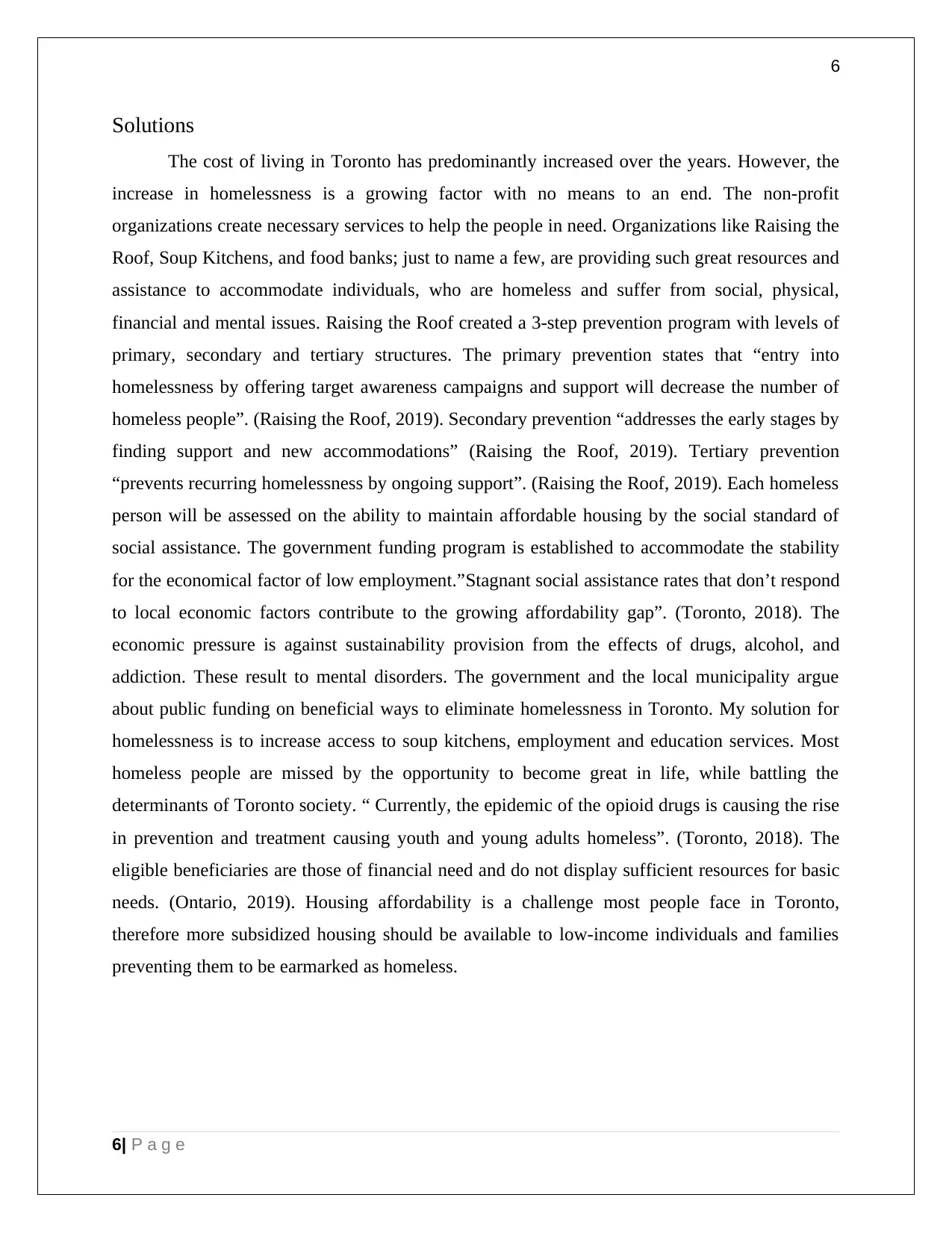
6
Solutions
The cost of living in Toronto has predominantly increased over the years. However, the
increase in homelessness is a growing factor with no means to an end. The non-profit
organizations create necessary services to help the people in need. Organizations like Raising the
Roof, Soup Kitchens, and food banks; just to name a few, are providing such great resources and
assistance to accommodate individuals, who are homeless and suffer from social, physical,
financial and mental issues. Raising the Roof created a 3-step prevention program with levels of
primary, secondary and tertiary structures. The primary prevention states that “entry into
homelessness by offering target awareness campaigns and support will decrease the number of
homeless people”. (Raising the Roof, 2019). Secondary prevention “addresses the early stages by
finding support and new accommodations” (Raising the Roof, 2019). Tertiary prevention
“prevents recurring homelessness by ongoing support”. (Raising the Roof, 2019). Each homeless
person will be assessed on the ability to maintain affordable housing by the social standard of
social assistance. The government funding program is established to accommodate the stability
for the economical factor of low employment.”Stagnant social assistance rates that don’t respond
to local economic factors contribute to the growing affordability gap”. (Toronto, 2018). The
economic pressure is against sustainability provision from the effects of drugs, alcohol, and
addiction. These result to mental disorders. The government and the local municipality argue
about public funding on beneficial ways to eliminate homelessness in Toronto. My solution for
homelessness is to increase access to soup kitchens, employment and education services. Most
homeless people are missed by the opportunity to become great in life, while battling the
determinants of Toronto society. “ Currently, the epidemic of the opioid drugs is causing the rise
in prevention and treatment causing youth and young adults homeless”. (Toronto, 2018). The
eligible beneficiaries are those of financial need and do not display sufficient resources for basic
needs. (Ontario, 2019). Housing affordability is a challenge most people face in Toronto,
therefore more subsidized housing should be available to low-income individuals and families
preventing them to be earmarked as homeless.
6| P a g e
Solutions
The cost of living in Toronto has predominantly increased over the years. However, the
increase in homelessness is a growing factor with no means to an end. The non-profit
organizations create necessary services to help the people in need. Organizations like Raising the
Roof, Soup Kitchens, and food banks; just to name a few, are providing such great resources and
assistance to accommodate individuals, who are homeless and suffer from social, physical,
financial and mental issues. Raising the Roof created a 3-step prevention program with levels of
primary, secondary and tertiary structures. The primary prevention states that “entry into
homelessness by offering target awareness campaigns and support will decrease the number of
homeless people”. (Raising the Roof, 2019). Secondary prevention “addresses the early stages by
finding support and new accommodations” (Raising the Roof, 2019). Tertiary prevention
“prevents recurring homelessness by ongoing support”. (Raising the Roof, 2019). Each homeless
person will be assessed on the ability to maintain affordable housing by the social standard of
social assistance. The government funding program is established to accommodate the stability
for the economical factor of low employment.”Stagnant social assistance rates that don’t respond
to local economic factors contribute to the growing affordability gap”. (Toronto, 2018). The
economic pressure is against sustainability provision from the effects of drugs, alcohol, and
addiction. These result to mental disorders. The government and the local municipality argue
about public funding on beneficial ways to eliminate homelessness in Toronto. My solution for
homelessness is to increase access to soup kitchens, employment and education services. Most
homeless people are missed by the opportunity to become great in life, while battling the
determinants of Toronto society. “ Currently, the epidemic of the opioid drugs is causing the rise
in prevention and treatment causing youth and young adults homeless”. (Toronto, 2018). The
eligible beneficiaries are those of financial need and do not display sufficient resources for basic
needs. (Ontario, 2019). Housing affordability is a challenge most people face in Toronto,
therefore more subsidized housing should be available to low-income individuals and families
preventing them to be earmarked as homeless.
6| P a g e
⊘ This is a preview!⊘
Do you want full access?
Subscribe today to unlock all pages.

Trusted by 1+ million students worldwide
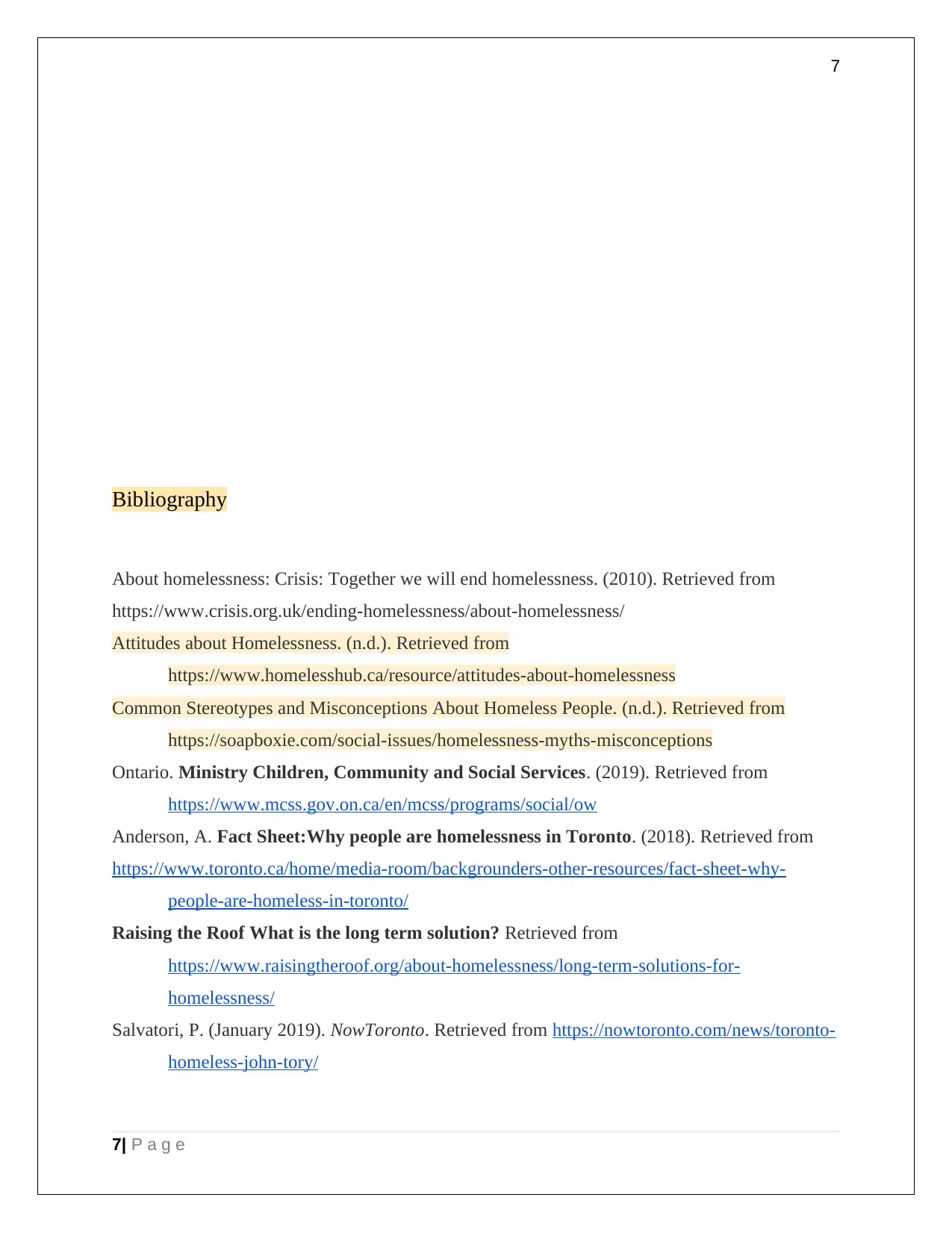
7
Bibliography
About homelessness: Crisis: Together we will end homelessness. (2010). Retrieved from
https://www.crisis.org.uk/ending-homelessness/about-homelessness/
Attitudes about Homelessness. (n.d.). Retrieved from
https://www.homelesshub.ca/resource/attitudes-about-homelessness
Common Stereotypes and Misconceptions About Homeless People. (n.d.). Retrieved from
https://soapboxie.com/social-issues/homelessness-myths-misconceptions
Ontario. Ministry Children, Community and Social Services. (2019). Retrieved from
https://www.mcss.gov.on.ca/en/mcss/programs/social/ow
Anderson, A. Fact Sheet:Why people are homelessness in Toronto. (2018). Retrieved from
https://www.toronto.ca/home/media-room/backgrounders-other-resources/fact-sheet-why-
people-are-homeless-in-toronto/
Raising the Roof What is the long term solution? Retrieved from
https://www.raisingtheroof.org/about-homelessness/long-term-solutions-for-
homelessness/
Salvatori, P. (January 2019). NowToronto. Retrieved from https://nowtoronto.com/news/toronto-
homeless-john-tory/
7| P a g e
Bibliography
About homelessness: Crisis: Together we will end homelessness. (2010). Retrieved from
https://www.crisis.org.uk/ending-homelessness/about-homelessness/
Attitudes about Homelessness. (n.d.). Retrieved from
https://www.homelesshub.ca/resource/attitudes-about-homelessness
Common Stereotypes and Misconceptions About Homeless People. (n.d.). Retrieved from
https://soapboxie.com/social-issues/homelessness-myths-misconceptions
Ontario. Ministry Children, Community and Social Services. (2019). Retrieved from
https://www.mcss.gov.on.ca/en/mcss/programs/social/ow
Anderson, A. Fact Sheet:Why people are homelessness in Toronto. (2018). Retrieved from
https://www.toronto.ca/home/media-room/backgrounders-other-resources/fact-sheet-why-
people-are-homeless-in-toronto/
Raising the Roof What is the long term solution? Retrieved from
https://www.raisingtheroof.org/about-homelessness/long-term-solutions-for-
homelessness/
Salvatori, P. (January 2019). NowToronto. Retrieved from https://nowtoronto.com/news/toronto-
homeless-john-tory/
7| P a g e
Paraphrase This Document
Need a fresh take? Get an instant paraphrase of this document with our AI Paraphraser
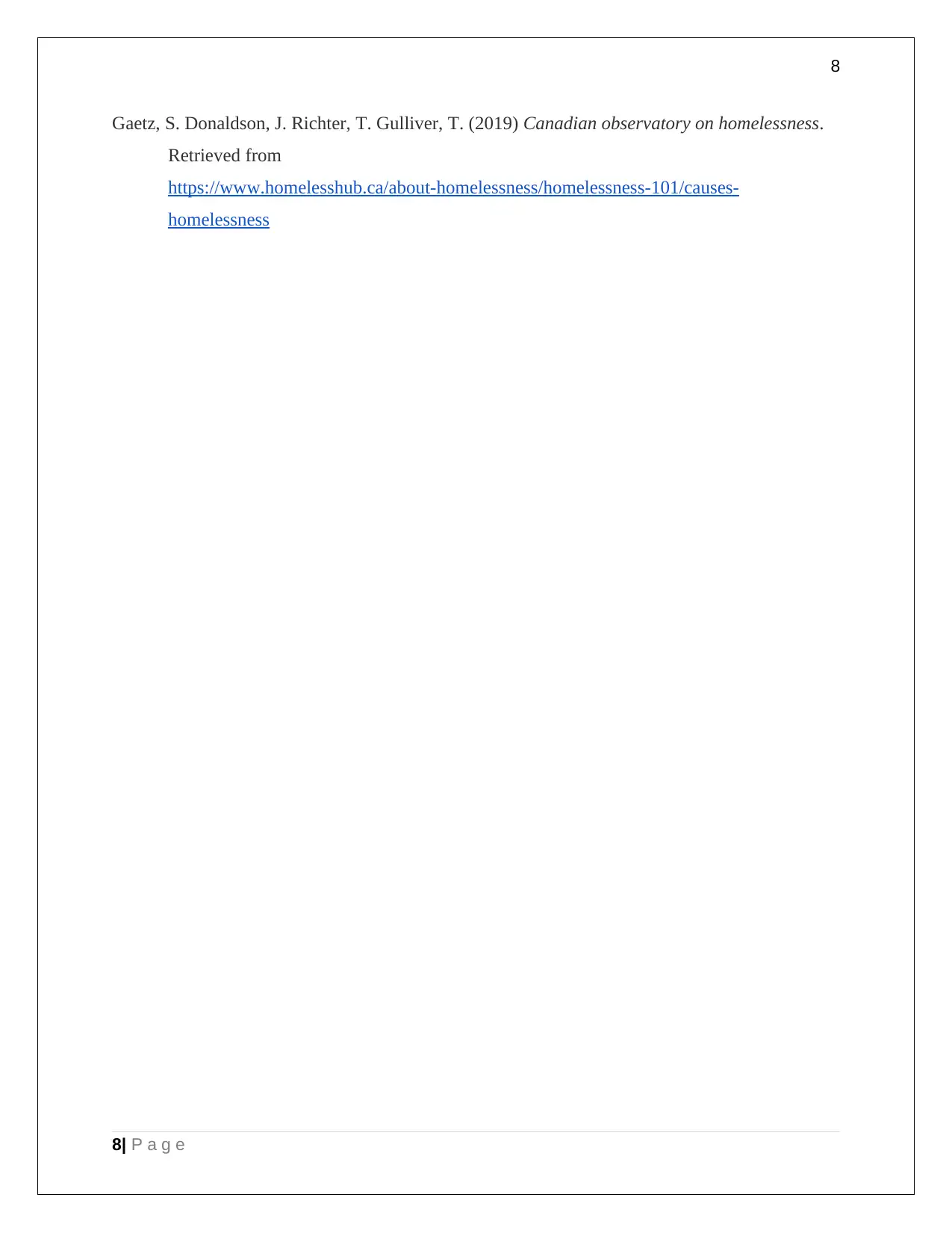
8
Gaetz, S. Donaldson, J. Richter, T. Gulliver, T. (2019) Canadian observatory on homelessness.
Retrieved from
https://www.homelesshub.ca/about-homelessness/homelessness-101/causes-
homelessness
8| P a g e
Gaetz, S. Donaldson, J. Richter, T. Gulliver, T. (2019) Canadian observatory on homelessness.
Retrieved from
https://www.homelesshub.ca/about-homelessness/homelessness-101/causes-
homelessness
8| P a g e
1 out of 8
Your All-in-One AI-Powered Toolkit for Academic Success.
+13062052269
info@desklib.com
Available 24*7 on WhatsApp / Email
![[object Object]](/_next/static/media/star-bottom.7253800d.svg)
Unlock your academic potential
Copyright © 2020–2025 A2Z Services. All Rights Reserved. Developed and managed by ZUCOL.